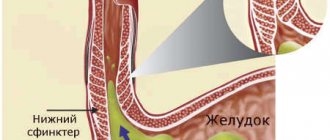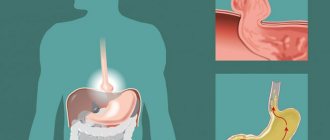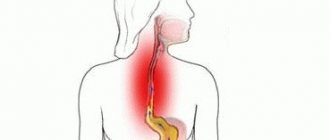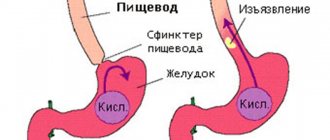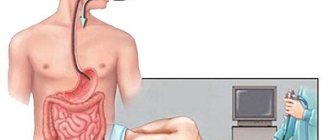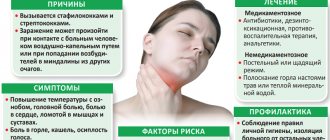Esophagitis is one of the diseases of the gastrointestinal tract, namely, inflammatory damage to the mucous membrane of the esophagus.
Gastroesophageal reflux disease (GERD) has become increasingly common over the past few years. It, along with oncological and cardiovascular pathologies, can be considered one of the most common diseases of the 21st century. Moreover, severe forms of the disease, such as Barrett's esophagus, which is considered a precancerous disease, are increasingly being observed. Let's take a closer look at the topic of 1st, 2nd, 3rd, 4th degree esophagitis.
What is important to know
The relevance of the problem of GERD is also due to the fact that almost every second inhabitant of the planet periodically experiences symptoms of this disease, unaware of its presence in their body. What is the danger of this disease?
- first of all, in reducing the quality of life of the patients themselves;
- secondly, in severe complications such as the development of peptic ulcers , stenosis and perforation of the esophagus .
Studies of the disease have established a clear relationship that the gastroesophageal reflux factor can be traced in the genesis of some dental diseases, ENT diseases, as well as bronchopulmonary and cardiovascular diseases. But, despite the relevance of the problems associated with esophagitis, its danger is underestimated.
In this regard, it is important to find out how esophagitis manifests itself in its most common form.
Division of reflux esophagitis according to the extent of the lesion
First of all, reflux esophagitis is divided according to the prevalence of the lesion. That is, how high the esophageal mucosa is affected during the reflux of gastric contents.
- Distal reflux esophagitis - damage only the final part of the esophagus, only a few centimeters of the mucosa above the esophagogastric junction are changed. The most common and easy-to-flow option.
- Widespread reflux esophagitis - the presence of changes within half the length of the esophagus.
- Subtotal reflux esophagitis is a lesion of a significant part of the esophagus, but not the entire mucosa. A rather severe form, characterized by high reflux of gastric contents.
- Total reflux esophagitis - the mucous membrane of the entire esophagus is changed by the effects of peptic enzymes. The most severe form. Most often, such damage occurs in people leading an asocial lifestyle (long-term drug or alcohol intoxication) and bedridden patients (especially in seriously ill patients)
Hemorrhagic erosions along the entire length of the esophagus
Esophagitis 1st degree: what is it?
Esophagitis is an inflammation of the esophagus associated with improper functioning of the muscular sphincter connecting it to the stomach. Normally, it prevents the contents of the stomach from entering the esophagus.
The first degree of esophagitis involves a weakening of the sphincter, which does not close completely and allows the acidic contents of the stomach to pass through. The esophageal mucosa, which is not intended for contact with acid and has a neutral environment, receives burns, which causes certain symptoms of first-degree esophagitis. In total, the pathology has several degrees of its manifestation, depending on the stage of the process and the area of damage to the esophageal mucosa.
So, the symptoms of first degree GERD are:
- Heartburn . Normally, heartburn can occur in a completely healthy person, but if this condition is permanent, then this indicates the manifestation of signs of esophagitis.
- Belching . It is most often observed when drinking alcohol.
- Soreness and burning sensation in the throat .
- Feeling of a lump stuck in the throat after physical activity, difficulty swallowing.
- Chest pain after eating.
There may be other symptoms that seem to be unrelated to either the esophagus or digestion. For example, due to a slight displacement of the stomach in the abdominal cavity, it can compress the lungs and bronchi. This in turn causes periodic coughing. Emissions from the stomach with large amounts of hydrochloric acid negatively affect the condition of tooth enamel. It undergoes constant destruction, which is the cause of the development of caries.
The disease at this stage of development has small areas of damage to the esophageal mucosa, not exceeding 5 mm in diameter.
Causes of grade 1 esophagitis
The main reason for the development of GERD is weakness of the neuromuscular part of the esophagus, namely its sphincter. Factors predisposing to the development of esophagitis are:
- poor-quality, irrational nutrition;
- alcohol abuse, smoking ;
- antispasmodic and sedative medications;
- eating large amounts of sweet and spicy foods ;
- past infectious diseases that were severe or with complications (diphtheria, scarlet fever, sepsis);
- various damage to the mucous membrane of the esophagus : chemical, thermal, mechanical;
- surgical interventions for gastrectomy, gastrectomy and other types of surgical treatment;
- the presence of a hiatal hernia;
- gastritis;
- obesity;
- peptic ulcer of the stomach and duodenum;
- fungal and viral infections;
- chemotherapy.
The disease, without appropriate treatment, develops further and passes into other stages.
Diagnosis and treatment
Treatment of esophagitis
Diagnosis of any type of disease consists of laboratory tests of blood, urine, gastric contents and feces. This is necessary to detect the causes of the disease, associated disorders or complications. In addition, instrumental examinations of the patient are carried out, which are aimed at studying the structure of the mucous membrane of the esophagus and other organs of the gastrointestinal tract, as well as determining the presence of oncology.
Treatment is prescribed individually for each patient and is comprehensive. Therapy consists of:
- prescribing medications that eliminate symptoms and some causes of the formation of one or another type of esophagitis;
- non-drug treatments such as diet and physical therapy;
- folk remedies;
- surgical intervention - used extremely rarely, in severe cases of the disease or the presence of complications.
The prognosis of the disease depends entirely on timely treatment. It is often favorable, but in the presence of consequences, in particular Barrett's syndrome, it is more sad.
Esophagitis 2, 3 and 4 degrees
According to available observations, it usually takes 2-3 years from the onset of the disease to seeking medical help. As a rule, the first degree of the disease goes unnoticed for the patient and when he consults a doctor, he is diagnosed with esophagitis of the 2nd degree. What is this? Let's figure it out.
In total, there are 4 degrees of pathology:
- the first, with a affected area no more than 5 mm in diameter;
- the second, with one or more defects with a diameter of more than 5 mm ;
- third, with extensive lesions of the mucous membrane ( up to 75% );
- the fourth, with damage to the inner surface of the esophagus by more than 75% .
The second degree of esophagitis requires increased attention. The fact is that it is at this stage that the disease progresses, manifesting itself with severe symptoms and the development of complications. This form of pathology is more difficult to treat, and the recovery process is longer and more complex.
Symptoms
At this stage of the disease, the symptoms are more pronounced and begin to bother the patient:
- regular chest pain that occurs unrelated to eating;
- in the area of the esophagus the patient has a constant burning sensation ;
- eating is accompanied by an uncomfortable urge to vomit. There are blood impurities in the vomit;
- hoarseness and difficulty swallowing;
- painful dry cough ;
- white coating on tongue;
- frequent sore throats.
Diagnostic data for grade 2 esophagitis:
- the esophageal mucosa is eroded and swollen, and looks like a continuous wound;
- the color of the epithelium is bright red;
- hemorrhages in erosive foci ;
- the mucosal surface may be severely inflamed and contain bloody or purulent exudate .
Although grade 2 esophagitis has severe symptoms and is characterized by significant damage to the esophageal mucosa, there are still no ulcerative formations at this stage of the pathology.
Esophagitis grade 3
GERD, which has progressed to the third stage of development, is characterized by spontaneous releases of undigested food with gastric juice. The functionality of the esophagus is sharply impaired, which leads to disruption of the gastrointestinal tract as a whole. Ulcerative lesions develop on the mucosa , which merge, covering the entire surface of the organ.
The initial form of esophagitis in children and pregnant women
Babies who have not yet learned to talk cannot explain their condition. But unpleasant phenomena for a child can be recognized during and after feeding. The child begins to shirk the spoon with food, often cries and coughs at night. Symptoms in small children differ slightly from the usual signs:
- Dyspnea.
- Nervousness.
- Increased body temperature.
- Restlessness in the evening.
- Prolonged crying.
- Night cough.
- Regurgitation, nausea and vomiting.
- Diarrhea.
If there are two signs from the above list, you should show the child to a pediatrician.
Among other things, a baby diagnosed with reflux esophagitis requires certain care. Since the baby has a spherical stomach, feeding should be done in a semi-vertical position. After eating, do not let your child fall asleep for about 2 hours. The pillow on the bed should be higher than usual (10-15 cm).
Classification of esophagitis
In the international systematization of diseases, esophageal pathology is usually differentiated into two different forms:
- GERD with esophagitis , or reflux esophagitis, in which there is erosive damage to the esophageal mucosa;
- Gastroreflux without esophagitis, or non-erosive reflux disease ( NERD ). It is not accompanied by the development of any defects in the esophageal mucosa.
In practice, the Los Angeles classification is most often used to differentiate esophagitis. What does the Los Angeles classification of esophagitis mean? It systematizes the stages of the disease depending on the degree of damage to the internal surface of the organ mucosa. This degree is indicated either by numbers (from 1 to 4) or by letters of the Latin alphabet.
The extent of the lesion is diagnosed using endoscopic examination . It is this classification that was considered in the proposed article.
Gastroesophageal reflux disease (GERD) (certificate for doctors)
a common part
Gastroesophageal reflux disease (GERD) is a disease characterized by the development of specific symptoms and/or inflammatory lesions of the distal esophagus due to repeated, retrograde flow of gastric and/or duodenal contents into the esophagus.
The pathogenesis is based on insufficiency of the lower esophageal sphincter (circular smooth muscle, which is in a state of tonic contraction in a healthy person and separates the esophagus and stomach), which contributes to the reflux of stomach contents into the esophagus (reflux).
Long-term reflux leads to esophagitis and sometimes to tumors of the esophagus. Typical (heartburn, belching, dysphagia) and atypical (cough, chest pain, wheezing) manifestations of the disease occur.
Pathological changes in the respiratory system (pneumonia, bronchospasm, idiopathic pulmonary fibrosis), vocal cords (hoarseness, laryngitis, laryngeal cancer), hearing organ (otitis media), teeth (enamel defects), may be additional signs indicating reflux .
The diagnosis is made based on a clinical assessment of the symptoms of the disease, the results of endoscopic studies, and pH-metry data (monitoring pH in the esophagus).
Treatment consists of lifestyle changes and taking medications that reduce gastric acidity (proton pump inhibitors). In some cases, surgical treatment methods may be used.
- Classification of GERD
First of all, the classification divides gastroesophageal reflux disease into 2 categories: GERD with esophagitis and GERD without esophagitis.
- GERD with esophagitis (endoscopically positive reflux disease)
Reflux esophagitis is damage to the mucous membrane of the esophagus, visible during endoscopy, an inflammatory process in the distal (lower) part of the esophagus caused by the action of gastric juice, bile, pancreatic and intestinal secretions on the mucous membrane of the esophagus. It is observed in 30-45% of patients with GERD.
Complications of reflux esophagitis are:
- Esophageal strictures.
- Erosion and ulcers of the esophagus, accompanied by bleeding.
- Barrett's esophagus.
- Adenocarcinoma of the esophagus.
The condition of the esophageal mucosa is assessed endoscopically according to the M.Savary-J.Miller classification, or according to the Los Angeles (1994) classification.
- Classification by M.Savary-J.Miller as modified by Carrison et al. Grade 0 – there are no signs of reflux esophagitis.
- I degree – non-confluent erosions against the background of mucosal hyperemia, occupying less than 10% of the circumference of the distal esophagus.
- Grade II – confluent erosive lesions occupying 10-50% of the circumference of the distal esophagus.
- III degree – multiple, circular erosive and ulcerative lesions of the esophagus, occupying the entire circumference of the distal esophagus.
- IV degree – complications: deep ulcers, strictures, Barrett’s esophagus.
- Grade A - one or more defects of the esophageal mucosa no more than 5 mm long, none of which extends to more than 2 folds of the mucous membrane.
- GERD without esophagitis (endoscopically negative reflux disease, or non-erosive reflux disease)
GERD without esophagitis (endoscopically negative reflux disease, or non-erosive reflux disease) is damage to the esophageal mucosa that is not detected by endoscopic examination. Occurs in more than 50% of cases.The severity of subjective symptoms and duration of the disease do not correlate with the endoscopic picture. With endoscopically negative GERD, quality of life suffers in the same way as with reflux esophagitis, and pH measurements characteristic of the disease are observed.
- Epidemiology of GERD
The incidence of GERD is often underestimated, since only 25% of patients consult a doctor. Many people do not complain because they manage the symptoms of the disease with over-the-counter medications. The occurrence of the disease is promoted by a diet containing excess amounts of fat.
If we evaluate the prevalence of GERD by the frequency of heartburn, then 21-40% of residents of Western Europe, up to 20-45% of residents of the USA and about 15% of residents of Russia complain about it. The likelihood of having GERD is high if you experience heartburn at least twice a week. In 7-10% of patients it occurs daily. However, even with more rare heartburn, the presence of GERD cannot be excluded.
The incidence of GERD in men and women of any age is (2-3):1. Incidence rates of GERD increase in people over 40 years of age. However, Barrett's esophagitis and adenocarcinoma are approximately 10 times more common in men.
Symptoms
The disease is characterized by:
- heartburn;
- belching;
- pain syndrome;
- dysphagia.
Heartburn is manifested by unpleasant sensations in the area of the xiphoid process.
A burning sensation occurs when bending forward, adopting a horizontal position, as well as during strong contraction of the esophageal tube, due to a nervous spasm when the contents of the stomach are refluxed into the esophagus.
Pain is caused by exposure to an acidic environment on the inflamed epithelium. During sleep, such patients may regurgitate and gastric secretions enter the respiratory tract, resulting in a cough and the possible development of aspiration pneumonia .
Belching is also a symptom of esophagitis, since it indicates that erosive reflux esophagitis occurs against the background of insufficiency of the cardia, a muscular valve located between the esophagus and the stomach and preventing gastric secretions from entering the esophageal tube.
Important! As the disease progresses, the patient develops dysphagia, which is characterized by impaired swallowing. Food seems to “get stuck” at the level of the xiphoid process.
This phenomenon occurs due to nervous muscle spasm or the presence of esophageal stenosis caused by scarring. The disease has complications in the form of bleeding, hidden recurring aspiration pneumonia, the presence of scars in the esophagus, stenosis, and its shortening.

